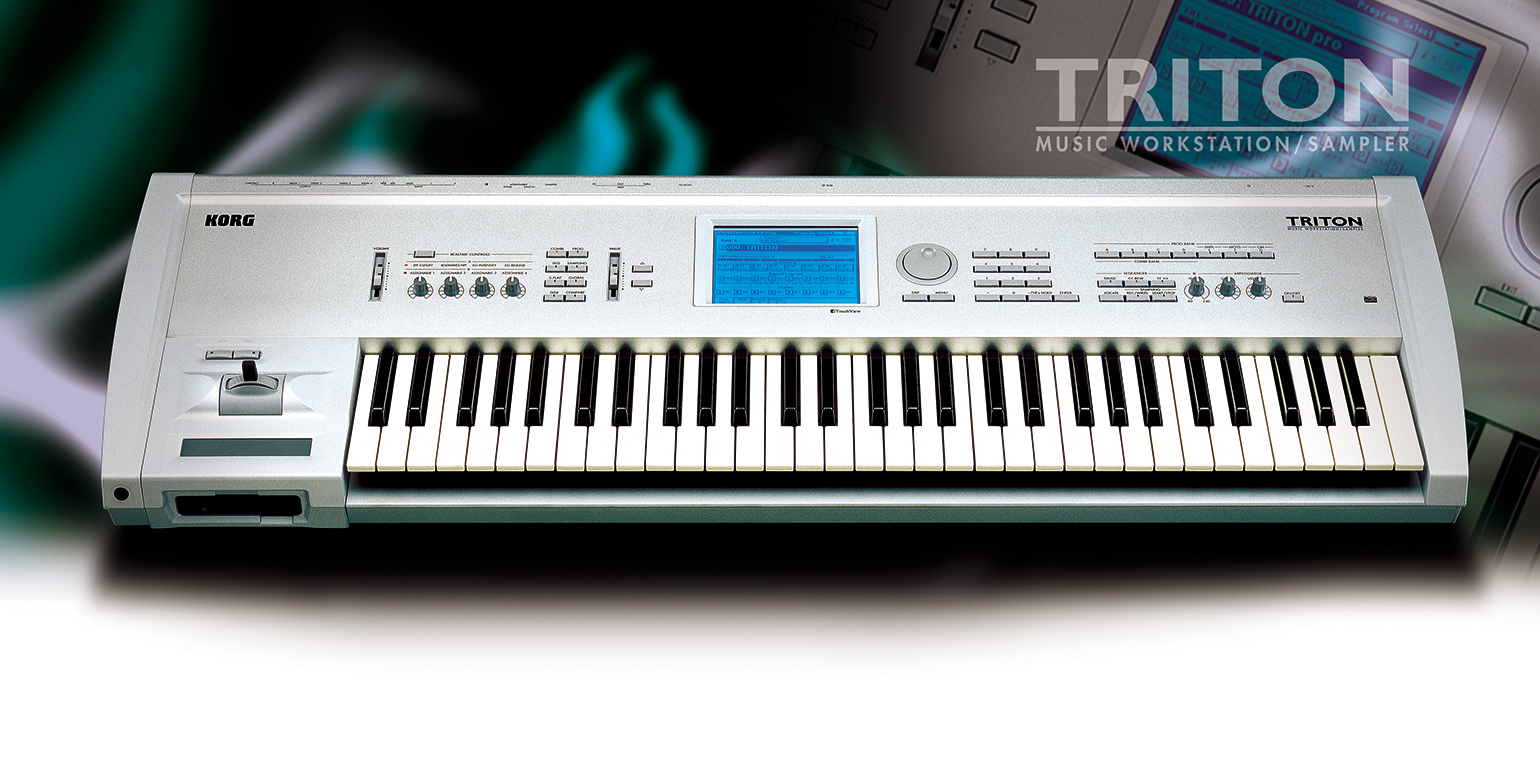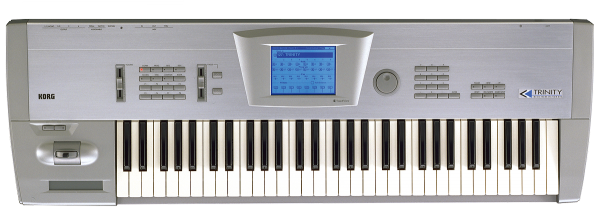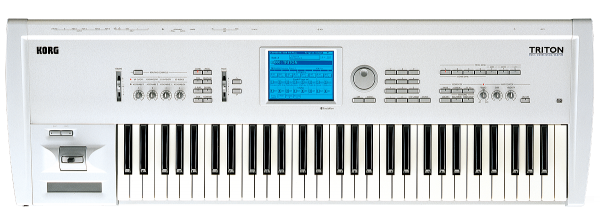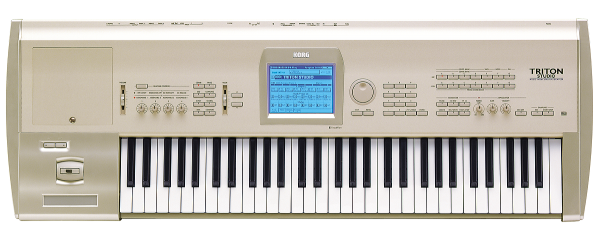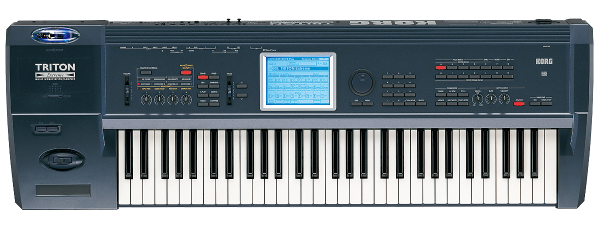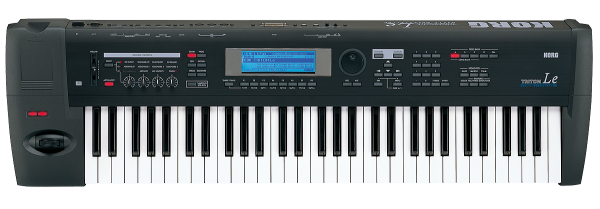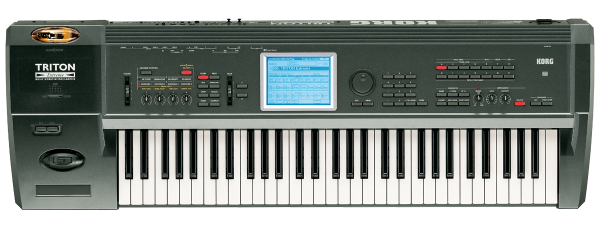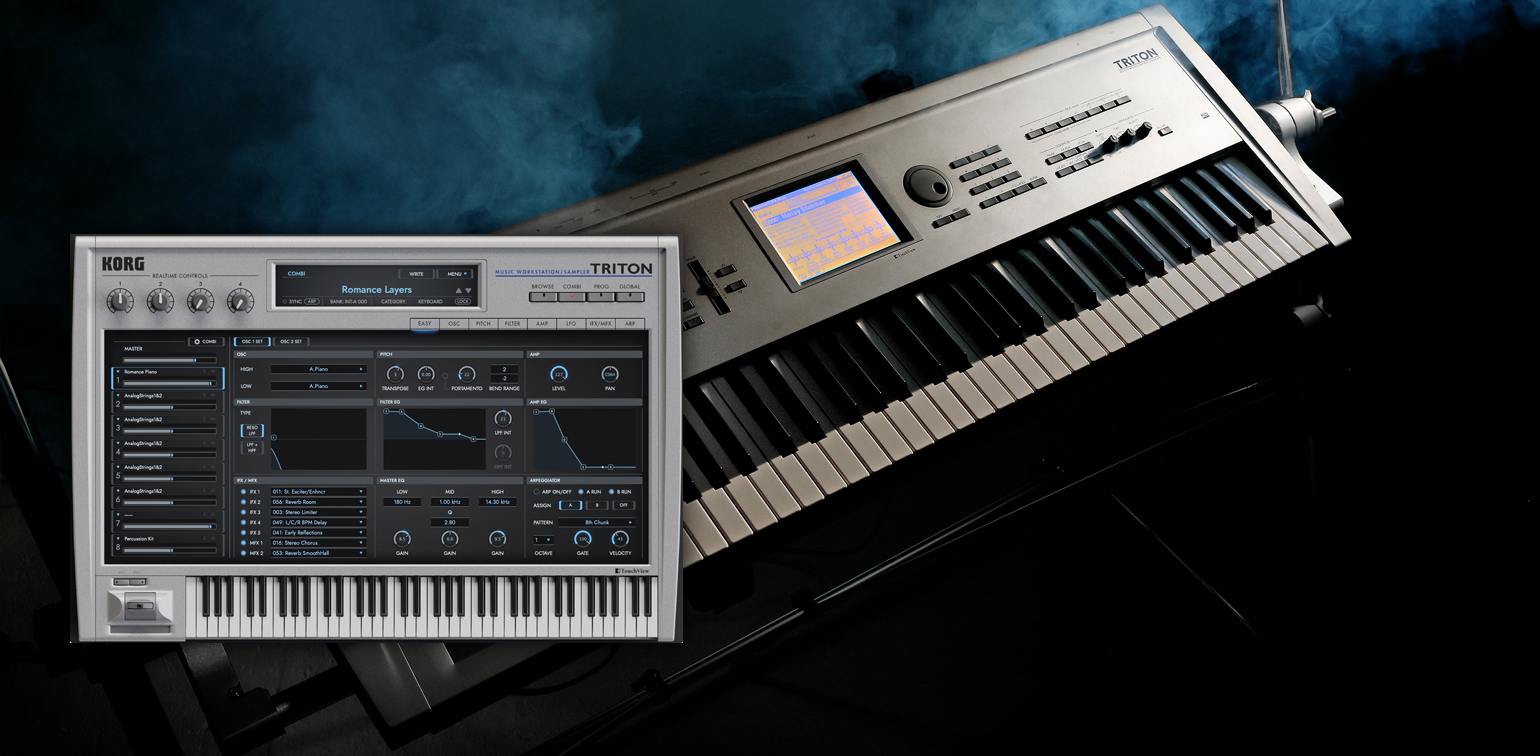
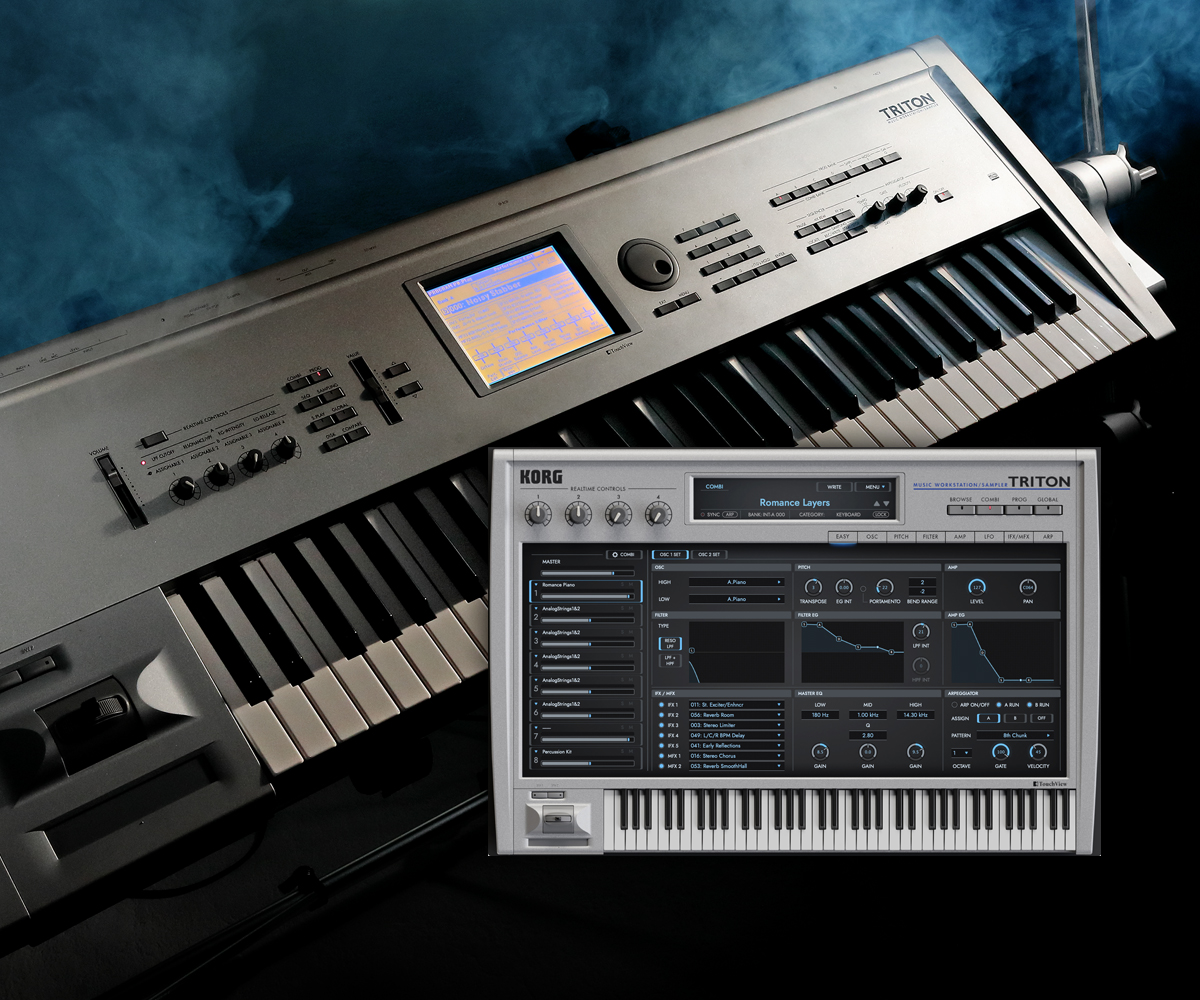
SoundCloud
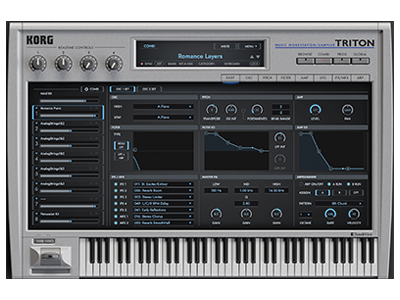
TRITON / TRITON Extreme for Mac/Win
MUSIC WORKSTATION
Support
Learn More
Related Products
 KORG Collection 6 for Mac/PC
KORG Collection 6 for Mac/PC M1 V2 for Mac/Win
M1 V2 for Mac/Win MDE-X V2 for Mac/Win
MDE-X V2 for Mac/Win- MS-20 V2 for Mac/Win
- Polysix V2 for Mac/Win
- Mono/Poly V2 for Mac/Win
- WAVESTATION V2 for Mac/Win
- ARP ODYSSEY for Mac/Win
- miniKORG 700S for Mac/Win
- Prophecy for Mac/Win
- KAOSS PAD for Mac/Win
- microKORG for Mac/Win
- ELECTRIBE-R for Mac/Win
- ARP 2600 for Mac/PC
- VOX Super Continental
- EP-1 for Mac/PC
- TRINITY for Mac/PC
The TRITON Story
How was the TRITON born, and how did it become such a high-performance machine? We briefly look back at that history with comments from engineers of the time.
Everything started from this one machine

The predecessor of the TRITON was the TRINITY, a workstation released in 1995. It had astoundingly high sound sound quality for the 1990s, and its revolutionary use of a touchscreen interface as well as the various functional enhancements possible through the option board (hard-disk recording, playback sampling, and the MOSS tone generator, among others) earned it high praise from top artists around the world.
Unfortunately, the sound quality and abundance of features on the TRINITY led to an unaffordably high price tag. To address this, the first generation of TRITON was developed with the goal of delivering a successor to the TRINITY that would have a lower price while still being comparable.
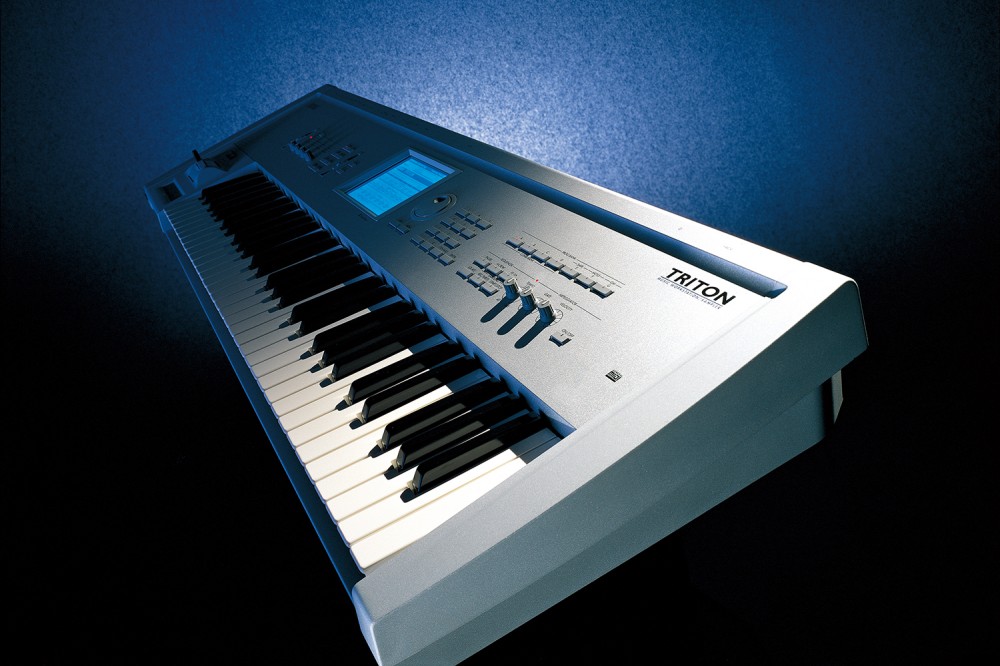
The first generation TRITON was released in 1999. The newly developed sound engine was name the Hyper Integrated synthesis system, or HI for short. In addition to the 62 voice polyphony, almost double that of TRINITY, the optional MOSS tone generator board could add six voices of polyphony from various DSP algorithms. This combination allowed for incredibly diverse sound design. The signal routing in TRITON was also a step up from the TRINITY, offering five insert effects, two master effects, and a master EQ that could be flexibly routed between.
The newly developed sampling mode was a major advantage of the TRITON, making it a perfect fit for dance music that relies heavily on phrase sampling and other techniques. Later OS upgrades brought even more advanced functionality like the time-slice function, which divided samples sounds into individual samples using transient detection, and time stretching, which allowed users to change the length of a sample without changing its pitch. Through these updates, the TRITON evolved to support even more flexible music-making.
Another noteworthy feature of the TRITON is the arpeggiator, which evolved from a conventional arpeggiator that could only play broken chords to a dual polyphonic arpeggiator capable of playing a wide variety of phrases. Using the arpeggiator, players could find inspiration in a different approach than their usual playing. The dedicated drum mode developed to play drum patterns via the arpeggiator vastly improved the ability of the TRITON to act as a rhythm section. This was useful not just for production, but for live performances as well. These features are now considered standard among music workstations, but they started with the TRITON.
The addition of these drum arpeggiators also came with a major expansion of the TRITON’s built-in drum sound samples. Many new, trendy drum kits were added, and the TRITON was updated with bass, synthesizer, and string samples suitable for club music, which was becoming mainstream at the time.
-
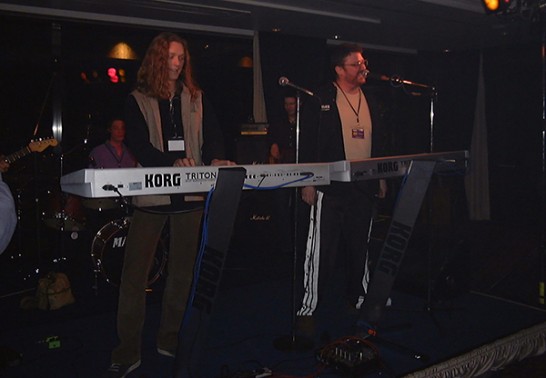
The first presentation of the TRITON at musikmesse
(Adam Wakeman and Steve McNally) -
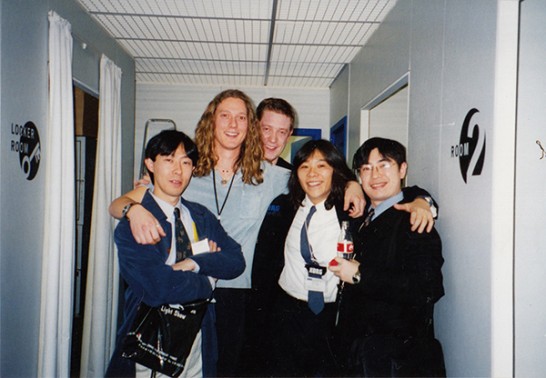
The members at the heart of the TRITON’s development
Differentiating itself from the high-quality sound of the TRINITY, which extended beautifully into the high registers, the TRITON’s merit was full, deep sound in the low-middle and low registers. This was partly thanks to the characteristics of the D/A converter used within; the full sound not only won the hearts of hip-hop and R&B artists, but also led to enthusiastic support from musicians across all genres. The TRITON sound could be heard on every artist's albums and in every venue.
Column: Creating TRITON sound
From Timbaland to The Neptunes, Swizz Beats, Massive Attack, Moby, Orbital, Utada Hikaru and more, TRITON sound has come to permeate a wide range of musical genres. So, how did the development team create preset sounds that would attract so many varied artists?
- "The tone generator chip used in the TRINITY was a high-end model oriented toward high sound quality, but the chip used in the TRITON focused more on versatility, and had major differences in its specifications as a tone generator. Many of its parameters are also significantly different. Meanwhile, we also wanted to include a wide variety of different tones, so we cut down little by little on the PCM data that is the source of the tones, while including as many different types as possible. I think all this work is one reason why the TRITON has full sound that differs from that of the TRINITY. Some of the PCM was moved over from the TRINITY, but we also included many things that were newly sampled."
"I remember that when we got the quality-assurance section manager at the time to check our demo songs, the manager gave us the stamp of approval, saying ‘This sound is amazing, especially the texture of the lows. This will definitely sell.’ Artists and producers felt those characteristics of the sound too, didn’t they?"
A developer of the new KORG Collection TRITON says:
"When we were checking the tones during development, we got sucked into playing all kinds of phrases for different tones without realizing - like ‘tones for club music would be like this, orchestral sound for film music would be like this’. That’s why the tone checks didn’t progress no matter how much time we had (laughs). I realized anew that part of the TRITON’s appeal is the fact that it’s filled with tones that naturally summon images like that."
The old KORG USA site has many past interviews with producers and keyboardists who regularly used the TRITON.
- Tommy Coster Jr | Korg - Artist Details (“The Real Slim Shady” Eminem)
- Dallas Austin and Narada Michael Walden | Korg - Artist Details (TLC etc.)
- Beyoncé Knowles of Destiny's Child | Korg - Artist Details
- Pharrell Williams (The Neptunes / N.E.R.D.) and Adam Blackstone | Korg - Artist Details
- Jae Deal with Mario | Korg - Artist Details
Column: Concentrating wisdom from around the world
Not only the TRITON but most KORG products are developed through the proactive collaboration of product specialists not just within Japan but around the world.
"Today, it’s easy to talk in real time and listen to sounds together through the internet. When we were first developing the TRITON, we had e-mail, but it was difficult to have face-to-face passionate discussions. So we got KORG’s product specialists from around the world together and put them in a confined space for a week where they had daily meetings in order to put the TRITON’s concept and specs together. It was an attempt to include as many of the needs of the time as we could. In the end, I think this meeting played a big role in making the TRITON a product that a wide range of musicians have kept using for a long time."
Column: Naming the TRITON
The name “TRITON” was created by the planners of the time.
- "Even though it had a lower price, we wanted to make it a product good enough to compete with the TRINITY, so we were always looking for a word for the name that started with ‘TRI’. We had about 200 proposals for names from various perspectives, including neologisms and words that didn’t start with ‘TRI’. While we were doing this, we suddenly thought of ‘TRITON’. The rhythm of the word is simple and easy to say, and because it ended with a ‘N’ sound, it had a well-defined rhythm too. So ‘TRITON’ became our final choice."
"When we first released it, we called the 61-key model the TRITON, the 76-key model the TRITON Pro, and the 88-key model the TRITON ProX. Later on, variation models and successor models were released, so in order to differentiate the first-generation TRITON from the rest, it was also called the TRITON Classic. This wasn’t an officially planned name, but of course we were happy that it was being called that. It proved that the TRITON had become established as a standard model."
An era of evolution and specialization
The TRITON series started with a lineup of three models - the 61-, 76-, and 88-key versions - but in response to market demand for functionality evolution and variation models, various new models were created.

First, the
TRITON-Rack was released in 2000. It contained the powerful tone generator and sampler functions of the first-generation TRITON within a 2U rack, and could be equipped with up to eight EXB-PCM series optional PCM boards, while the first-generation TRITON could only be equipped with two. The number of programs that could be stored within internal memory was also significantly increased to 2,057 programs and 1,664 combinations.
In addition to functions from the lineup of the first-generation TRITON, such as EXB-DI, which allowed for the installation of an ADAT output terminal, EXB-MOSS, which allowed for the addition of a MOSS tone generator, and EXB-SCSI, which allowed for the addition of an SCSI terminal, the TRITON-Rack also allowed for the EXB-mLAN expansion, which enabled the machine to connect to mLAN, the newest digital network at the time.
Column: Expanding TRITON sound
The EXB-PCM series of PCM expansion boards that could be installed in the TRITON series as well as the KARMA and other music workstations included eight options separated by theme.
"Although it was an optional expansion, that was the amount of capacity that was available at the time, so we made it so it would have enough power to rival a new model of synthesizer. You could expand the machine according to the type of sounds you wanted, so I think that expandability was very appealing."
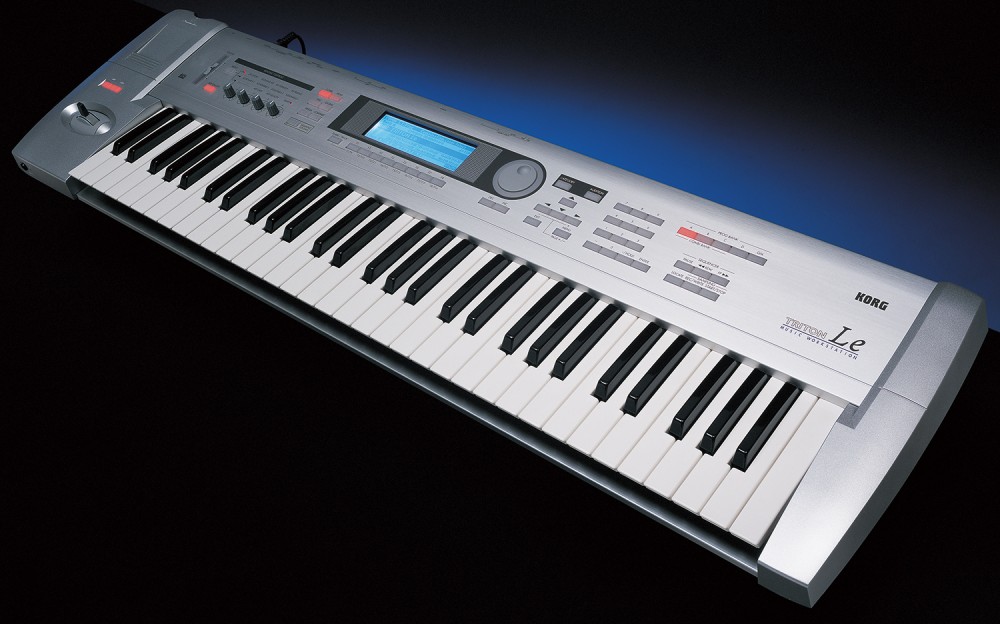
In 2001, the
TRITON Le was released. It kept the TRITON’s tone generator systems almost exactly the same, but came with a much lower price tag. The same PCM and effects as the first-generation TRITON were available, although the insert effects were more limited. The same 16-track, 200,000-note sequencer, dual arpeggiators, and RPPR functionality were likewise included. The internal presets included a large number of newly programmed sounds, mainly sounds suitable for dance music. The machine was intended to deliver an update to presets to suit the audience of the original.
The TRITON Le also included the capabilities of the EXB-SMPL sampling board for the first generation TRITON, making it a low cost model with high potential. It also featured improvements to the user interface with the addition of the function keys originally developed for the TRITON-Rack. These keys helped to make the TRITON-Le fast and easy to use on a compact display.
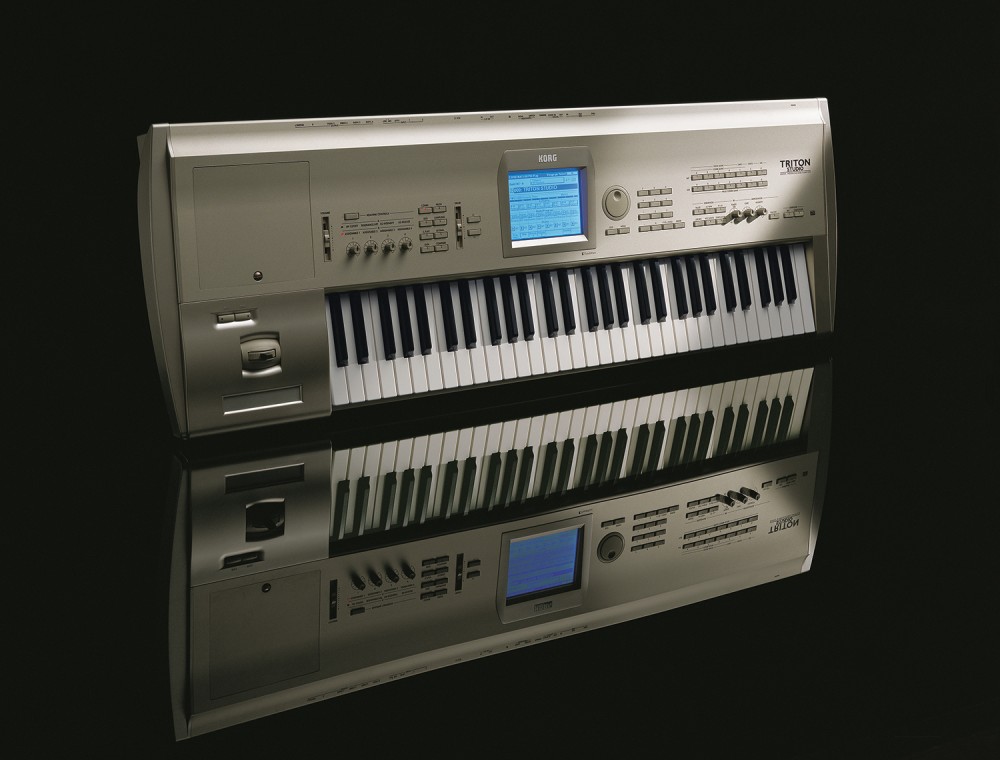
The next evolution was the
TRITON STUDIO in 2002. In addition to the PCM of the first-generation TRITON, the tone generator was expanded to include high-quality stereo piano PCM and could produce a maximum of 120 voices (60+60 voices during single mode), nearly double the polyphony of the first-generation TRITON. Furthermore, the machine could be equipped with up to seven EXB-PCM expansion PCM boards, and was designed in a user-friendly way that allowed the boards to be installed from the front panel. An optional CD-R/RW drive could also be installed, which not only enabled the creation and ripping of audio CDs, but also expanded the usefulness of the sampling functions. The hard disk was also built into the main body of the machine, allowing performances done on the main-body synthesizer to be saved in an uncompressed audio file. The expanded feature set made it an excellent option for studio use.
On the design side, the champagne gold rather than the first-generation’s silver and the flowing curves of the design were both well-received.
Column: Designing the TRITON
The silver body inherited from the TRINITY line was a very rare color for synthesizers at the time, creating a very impactful design.
- "What I said to the designers about the TRITON was that it should ‘have flashes of distinctiveness amidst its orthodoxy’. As a result, a new design was created that might look simple and unrefined at first, but is definitely unforgettable. For the TRITON STUDIO, I didn’t give those sort of instructions and asked the designers to work freely. The design that came out was one that kept its TRITON qualities, but absolutely let you feel the machine’s evolution."
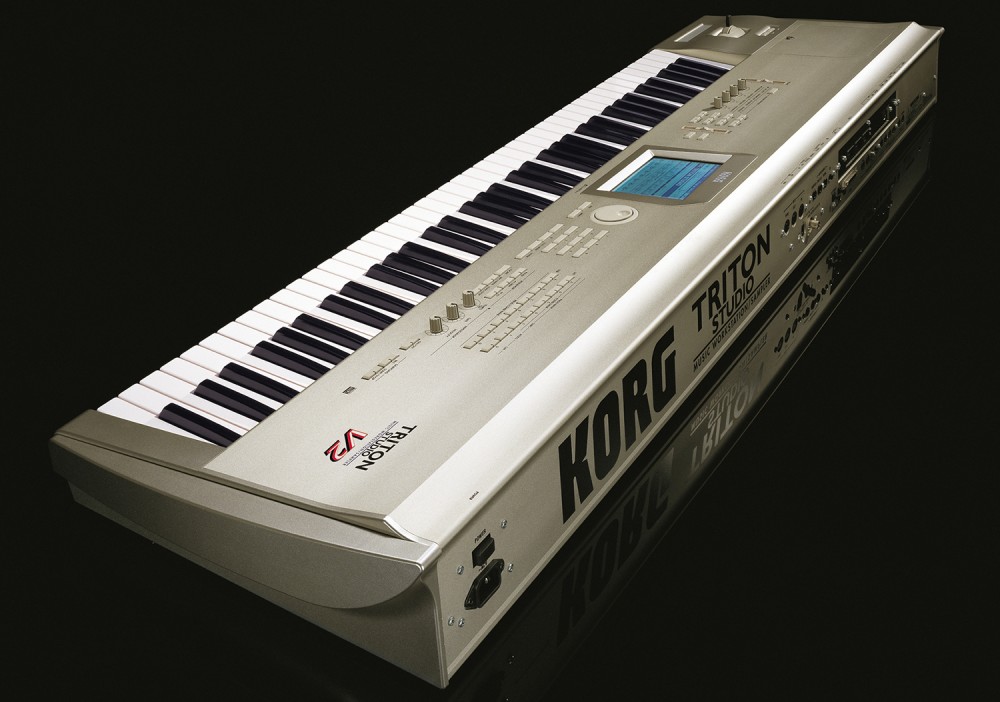
The
TRITON STUDIO V2 was released the next year in 2003, adding audio-track functionality using the built-in HDD. This function only allowed for two tracks, but it supported track bouncing (ping-pong recording) as well as per-track signal routing with built-in effects, making it possible to use the audio-track in the same manner as the synthesizer section. This function could also be linked to the In-Track Sampling function that had been installed on previous models, allowing this model to create an even more diverse music production environment.
In addition to the above, the TRITON STUDIO was also filled with specific functionality expansions and improvements that scratched users’ itches with regard to music production, such as a tone-adjust function that allowed for temporary tone adjustments to be done easily, an auto song setup function that allowed for songwriting to be done in one go from program/combination mode, loading from sample CDs and ripping from audio CDs, a function for editing WAV files sampled on the main body, and tap tempo controls.
The strongest model in the series appears

The next model to emerge was the TRITON Extreme in 2004. It was a new workstation that used navy blue rather than the metallic silver or champagne gold colors that had been used in previous models. In addition to the newly added PCM data, almost all of the PCM waveforms from the EXB-PCM series PCM expansion boards were preloaded into the main body. This created a “fully loaded” model that was truly extreme, and that was the strongest in the series.
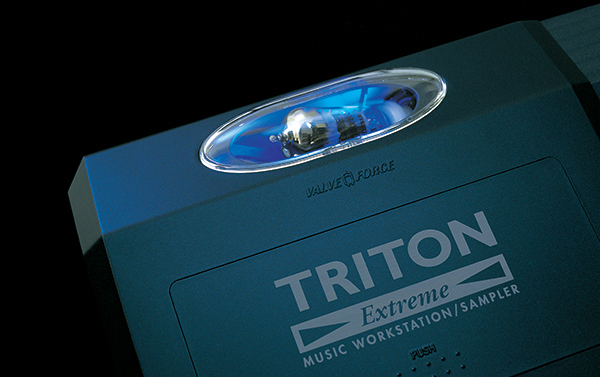
But after all is said and done, the most attention-grabbing aspect of the TRITON EXTREME was the installation of a vacuum tube. This was the first attempt of its time in a workstation keyboard. The circuit linked to the vacuum tube was known as Valve Force, and allowed the powerful, analog sound characteristic of a vacuum tube to be drawn out. This was immensely useful in creating rich sound that would not have been possible on other fully digital machines.
The tone generator supported a maximum of 120 (60+60) voices like the TRITON STUDIO, and the available effects were the same. The TRITON Extreme also included the Open Sampling System that had been well-received on the TRITON STUDIO and significantly increased the number of built-in preloaded data files in the dual polyphonic arpeggiators, making it even easier to use. The machine was also equipped with USB type-A and type-B connectors, allowing it to be easily connected to various storage devices. Card slots compatible with CompactFlash and Microdrive also enabled storing and loading data from the main body, making the machine compatible with the storage media that were developing rapidly at the time.
Column: Evolving the TRITON
The looks of the TRITON Extreme had a completely different feeling from those of the TRITON or TRITON STUDIO. What was the aim of that?
"During development, we focused on creating the best possible machine, so we brought in optional boards and updated USB compatibility and storage to create a product that was even easier to use than it had been before. Media in the TRITON STUDIO era meant floppy disks and SCSI, but this was now a time where storage media trends were changing to bring in CompactFlash, SmartMedia, and SD cards, so an update on that side was necessary."
Column: Installing the vacuum tube
- "Before the TRITON Extreme, we had the ELECTRIBE MX/SX, which used vacuum tubes and were well-received, so we brought the vacuum tube into the TRITON Extreme as well. The ELECTRIBE MX/SX had two vacuum tubes that allowed stereo output, but afterwards we realized that we could achieve stereo output with just one tube. We also added a switch function that bypassed the vacuum tube circuit. I think this created the enjoyment of being able to use different functions for different tones."
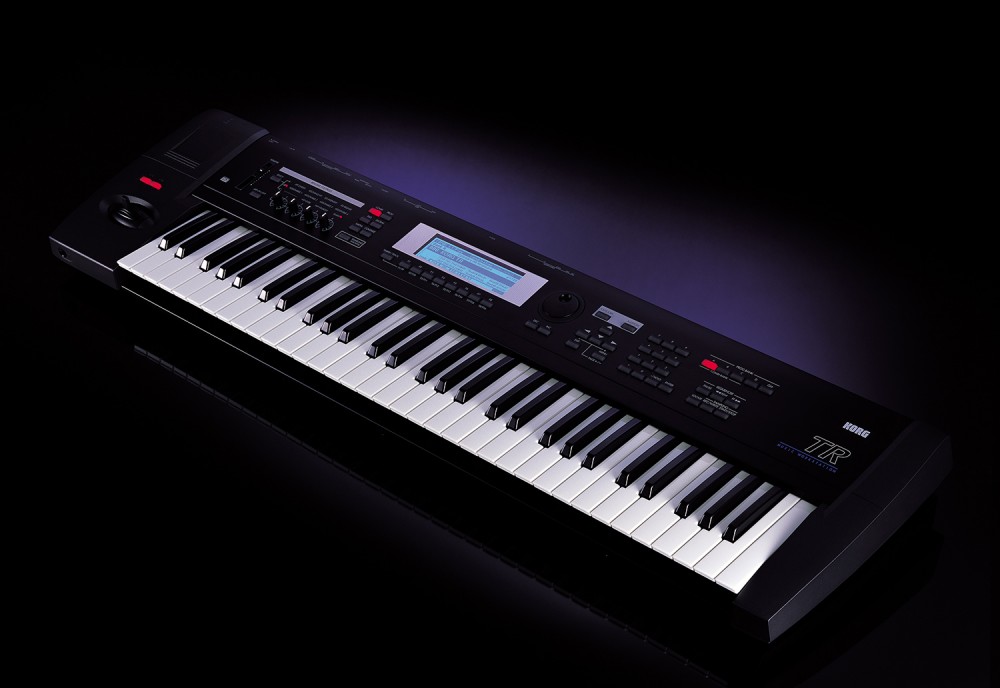
The
TR was also released in 2005, which could be described as the final work of the TRITON series. In addition to the 61 and 76-key models, an 88-key model was added in 2006. This was an active model that contained all the basic professional features of the TRITON series, which had become a global standard, within a lightweight body that could be easily handled.
It was a popular entry model with an even lower price that had the same basic specifications as the TRITON Le, but also had functionality updates to suit the changing times, such as the installation of a USB terminal and SD card compatibility.
Conclusion
After the birth of the first-generation TRITON, the TRITON series grew immensely. From the rack model, to the LE, to the Extreme, each iteration brought new innovations and features. Between the late 1990s and the mid 2000s technology naturally evolved, but the music scene also developed in a diverse way. During this time, we released many products that flexibly respond to technical developments as well as changes in the music scene; products from the TRITON series could be seen wherever one looked. This situation can be said to be unique to the TRITON series, which can be described as having become a de facto standard among workstation keyboards. Since the Triton era, Korg workstations continued to to develop, from the M3 and OASYS to the current flagship models KRONOS and KROME.
The first-generation TRITON which laid this foundation has now been revived as a software instrument. After 20 years, the TRITON sound can now be resurrected on your computer. Whether you have known of the TRITON series since the first-generation model or not, we hope that you will enjoy the unique TRITON sound that differs from the ultra-high-quality, ultra-high-capacity sound of modern software instruments to your heart’s content. From the bottom of our hearts, we look forward to new music being born yet again.
